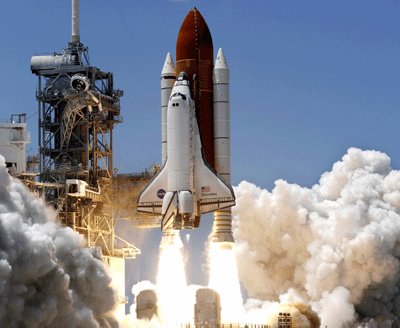The U.S. space shuttle Discovery blasted off from its seaside Florida launch
pad on Tuesday on a do-or-die mission for NASA's beleaguered shuttle program and
the half-built International Space Station.

The space shuttle
Discovery heads into space as it blasts off for Mission STS-121 at the
Kennedy Space Center in Cape Canaveral, Florida, July 4, 2006.
[Reuters] |
The shuttle and its seven-member crew lifted off at 2:38 p.m. EDT (1838 GMT)
following two postponements over the weekend because of poor weather at the
Kennedy Space Center.
"Great nations dare great things and take risks along the way and I can think
of no better way to explore the space frontier than the way we set out today,"
said shuttle program manager Wayne Hale.
The shuttle rocketed skyward atop a pillar of flame and orange-tinged smoke,
arcing over the Atlantic Ocean before settling into orbit.
A video camera mounted on the shuttle's fuel tank provided a magnificent view
of the ascent to space, but also caught sight of several pieces of foam
insulation flying off the fuel tank.
Shuttle managers have warned for weeks that the shuttle's fuel tank, which
was blamed for the 2003 Columbia accident, would continue to shed debris, but
that no pieces would be large enough to damage the shuttle in case of impact.
"This isn't too abnormal," said Bill Gerstenmaier, associate administrator
for spaceflight. "We fully expected to lose some foam."
The Discovery astronauts reported seeing foam debris and what appeared to be
an insulating blanket floating away.
NASA needs a successful mission to resume construction of the planned $100
billion space station, a project sponsored by 16 nations. Assembly of the
outpost has been on hold since the 2003 Columbia disaster.
NASA had hoped to resume station construction last year following the first
post-Columbia mission but the shuttle's fuel tank, like the one on Columbia,
shed large pieces of insulating foam during launch. Managers grounded the fleet
again for repairs.
Columbia was destroyed when a 1.67-pound (756-gram) chunk of foam broke off
the fuel tank and smashed into the ship's left wing. The damage was undetected
until after Columbia broke apart 16 days later as it flew through the
atmosphere, killing all seven astronauts aboard.
Another accident or serious problem on the current shuttle mission could
ground the fleet permanently.
NASA will get a preliminary look at how Discovery's tank fared during launch
later Tuesday when imaging experts pore over hundreds of photographs and
videotapes taken during the shuttle's climb.
The tank already has been redesigned twice and the agency's top engineer and
chief of safety had wanted to postpone Discovery's launch until after additional
work was done.
NASA Administrator Michael Griffin, however, decided to proceed with launch,
knowing that the shuttle crew could be housed aboard the space station if their
ship was hit by debris and sustained damage too severe to return home safely.
Delaying Discovery's launch, Griffin said, would put too much pressure on the
shuttle program, which needs to fly 16 missions to the station to complete
construction before 2010.
On Wednesday, the Discovery crew will begin detailed examinations of their
ship's heat shield for signs of damage from debris impacts.
NASA has spent about $1.3 billion fixing the shuttle's fuel tank and
developing other safety upgrades since the Columbia accident. The agency has no
more time or money to spend on major refurbishments if additional problems are
discovered.
Shuttle commander Steve Lindsey, 45, pilot Mark Kelly, 42, and mission
specialists Mike Fossum, 48, Lisa Nowak, 43, Stephanie Wilson, 39, and
British-born American Piers Sellers, 51, waved small American flags as they
headed from their quarters to the launch pad, marking the U.S. Independence Day.
Thomas Reiter, 48, of Germany, waved a German flag. He will be the first
European to live on the space station and is scheduled to return home in
December.